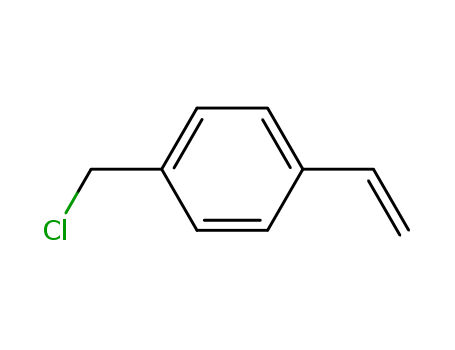- Chemical Name:1-(Chloromethyl)-4-vinylbenzene
- CAS No.:1592-20-7
- Molecular Formula:C9H9Cl
- Molecular Weight:152.623
- Hs Code.:29039990
- European Community (EC) Number:216-471-2
- UNII:CJL4OJ6BS0
- DSSTox Substance ID:DTXSID2061808
- Nikkaji Number:J91.309J
- Wikipedia:4-Vinylbenzyl_chloride
- Wikidata:Q28096079
- Mol file:1592-20-7.mol
Synonyms:4-Vinylbenzyl chloride;1592-20-7;1-(Chloromethyl)-4-vinylbenzene;1-(chloromethyl)-4-ethenylbenzene;4-(Chloromethyl)styrene;4-Chloromethylstyrene;Benzene, 1-(chloromethyl)-4-ethenyl-;p-vinylbenzyl chloride;CJL4OJ6BS0;EINECS 216-471-2;MFCD00051362;4-Vinylbenzyl chloride,contains 0.1% total stabilizer;p-chloromethylstyrene;4-vinyl benzylchloride;p-(chloromethyl)styrene;(4-vinylbenzyl)chloride;4-vinyl benzyl chloride;UNII-CJL4OJ6BS0;SCHEMBL35299;1-chloromethyl-4-vinylbenzene;4-Vinylbenzyl chloride, 90%;1-(chloromethyl)4-vinylbenzene;DTXSID2061808;1-(chloromethyl)-4-ethenyl-benzen;Vinylbenzyl Chloride (vbc) Monomer;AMY40230;1-(Chloromethyl)-4-vinylbenzene #;STL183304;AKOS006221481;FS-4211;C1792;FT-0658977;D78363;Vinylbenzylchloride;(4-Vinylbenzyl chloride);J-017738;W-107987;1-(Chloromethyl)-4-vinylbenzene, 500 ppm t-Butylcatechol inhibitor;4-Chloromethylstyrene, 90% stabilized with TBC+ONP+o-nitrocresol;4-(Chloromethyl)styrene (stabilized with TBC + ONP + 2-Nitro-p-cresol);1-(Chloromethyl)-4-vinylbenzene (stabilised with TBC + ONP + 2-Nitro-p-cresol);4-Vinylbenzyl chloride, technical, >=90% (GC), contains 0.1% total stabilizer



 C
C

